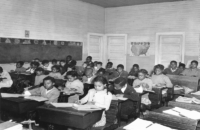 It is one of history’s ironies that African Americans, once barred from classrooms, became the fiercest champions of public schools after emancipation. They knew education was not just about literacy but about freedom, equality, and democracy itself. (Shown are Third, fourth, and fifth graders at Bethel Rosenwald School. Photo credit: National Archives)
It is one of history’s ironies that African Americans, once barred from classrooms, became the fiercest champions of public schools after emancipation. They knew education was not just about literacy but about freedom, equality, and democracy itself. (Shown are Third, fourth, and fifth graders at Bethel Rosenwald School. Photo credit: National Archives)
The NAACP carried this conviction into the courts, first winning cases like Sweatt v. Painter and McLaurin v. Oklahoma, which pried open professional schools to Black students. These early victories proved that segregation was indefensible and showed a path toward opportunity without dismantling the community-based Black schools that had anchored families.
But in 1954, the NAACP struck at the core of Jim Crow with Brown v. Board of Education. The Court’s ruling was a moral triumph, declaring that “separate educational facilities are inherently unequal.” Yet the aftermath revealed the costs. Black schools were shuttered, Black educators displaced, and students entered classrooms where bias and hostility remained. White families fled to suburbs, erected private “segregation academies,” and left public schools weakened.
That history reverberates today. Once again, public education—the only system obligated to serve every child—is under siege. The new culprits are vouchers, charter schools, and tax-subsidized segregation academies. Each drains resources from neighborhood schools, fragments communities, and deepens racial and economic divides. The Trump administration sharpened these trends by curtailing federal civil rights enforcement, opposing diversity efforts, and championing “choice” policies that accelerated resegregation.
Some argue that resegregation could bring benefits: a return to Black-led schools with more community control, as existed before Brown. Indeed, historically Black schools were crucibles of excellence, producing generations of leaders under conditions of exclusion. But history also offers a warning. Without equitable resources, resegregation will not empower communities—it will recreate the very “separate but unequal” conditions Brown sought to end. Control without funding is a mirage.
The evidence is clear. Segregation has risen since the 1990s. Nearly 60 percent of charter schools now serve student bodies that are over 90 percent minority, often with fewer resources than traditional public schools. Voucher programs in thirteen states funnel billions in public dollars into private schools, many with the freedom to exclude students by race, religion, or disability. And segregation academies, relics of defiance against Brown, still thrive today with taxpayer subsidies while remaining overwhelmingly white.
This is not “choice.” It is a slow-motion dismantling of the public system African Americans once saw as democracy’s lifeblood. Public schools remain the only institutions where children of all races, incomes, and abilities come together to share a civic life. Undermining them means weakening the very idea of a common democratic future.
The NAACP was right to confront segregation, but history shows that integration without equity is hollow—and that resegregation without resources is worse. Today’s fight is not just about education policy. It is about protecting democracy itself from erosion under the banner of privatization.
The lesson of history is clear: if we allow vouchers, unchecked charters, and subsidized academies to pull apart our schools, we will repeat the mistakes of the past. The fight for public education has always been a fight for freedom and equality. The question is whether we will invest in a system that lifts all children—or resign ourselves to a return of “separate but unequal” in new disguise.